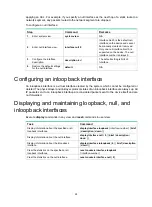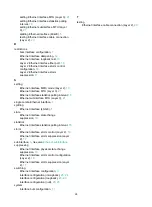
23
Configuring loopback, null, and
inloopback interfaces
This chapter describes how to configure a loopback interface, a null interface, and an inloopback
interface.
Configuring a loopback interface
A loopback interface is a virtual interface. The physical layer state of a loopback interface is always
up unless the loopback interface is manually shut down. Because of this benefit, loopback interfaces
are widely used in the following scenarios:
•
Configuring a loopback interface address as the source address of the IP packets that
the device generates
—Because loopback interface addresses are stable unicast addresses,
they are usually used as device identifications.
{
When you configure a rule on an authentication or security server to permit or deny packets
that a device generates, you can simplify the rule by configuring it to permit or deny packets
carrying the loopback interface address that identifies the device.
{
When you use a loopback interface address as the source address of IP packets, make
sure the route from the loopback interface to the peer is reachable by performing routing
configuration. All data packets sent to the loopback interface are considered packets sent to
the device itself, so the device does not forward these packets.
•
Using a loopback interface in dynamic routing protocols
—With no router ID configured for
a dynamic routing protocol, the system selects the highest loopback interface IP address as the
router ID. In BGP, to avoid interruption of BGP sessions due to physical port failure, you can use
a loopback interface as the source interface of BGP packets.
To configure a loopback interface:
Step Command
Remarks
1.
Enter system view.
system-view
N/A
2.
Create a loopback interface
and enter loopback interface
view.
interface loopback
interface-number
N/A
3.
Configure the interface
description.
description text
The default setting is
interface name
Interface
(for example,
LoopBack1
Interface
).
4.
Configure the expected
bandwidth of the loopback
interface.
bandwidth
bandwidth-value
By default, the expected bandwidth
of a loopback interface is 0 kbps.
5.
Restore the default settings
for the loopback interface.
default
N/A
6.
Bring up the loopback
interface.
undo shutdown
By default, a loopback interface is
up.
Configuring a null interface
A null interface is a virtual interface and is always up, but you cannot use it to forward data packets or
configure it with an IP address or link layer protocol. The null interface provides a simpler way to filter
packets than ACL. You can filter undesired traffic by transmitting it to a null interface instead of




















